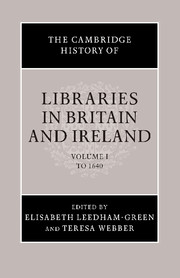Book contents
- Frontmatter
- Introduction
- The physical setting
- Part One The medieval library
- 2 Celtic Britain and Ireland in the early middle ages
- 3 Anglo-Saxon England
- 4 Monastic and cathedral book collections in the late eleventh and twelfth centuries
- 5 The libraries of religious houses in the late middle ages
- 6 College and university book collections and libraries
- 7 Bishops and kings: private book collections in medieval England
- 8 The medieval librarian
- 9 Borrowing and reference: access to libraries in the late middle ages
- Part Two Reformation, dissolution, new learning
- Part Three Tools of the trade
- Part Four Libraries for leisure
- Part Five Organisation and administration
- Select bibliography
- General index
- Index of manuscripts
- References
7 - Bishops and kings: private book collections in medieval England
from Part One - The medieval library
Published online by Cambridge University Press: 28 March 2008
- Frontmatter
- Introduction
- The physical setting
- Part One The medieval library
- 2 Celtic Britain and Ireland in the early middle ages
- 3 Anglo-Saxon England
- 4 Monastic and cathedral book collections in the late eleventh and twelfth centuries
- 5 The libraries of religious houses in the late middle ages
- 6 College and university book collections and libraries
- 7 Bishops and kings: private book collections in medieval England
- 8 The medieval librarian
- 9 Borrowing and reference: access to libraries in the late middle ages
- Part Two Reformation, dissolution, new learning
- Part Three Tools of the trade
- Part Four Libraries for leisure
- Part Five Organisation and administration
- Select bibliography
- General index
- Index of manuscripts
- References
Summary
Any attempt to trace the history of the book collections of individual men and women in England during the middle ages meets with difficult, indeed often insuperable, problems of evidence and interpretation. The evidence for true book collections belonging to individuals, embryo libraries, as opposed to small clutches of books, is at best partial and scattered. Much of it remains uncollated and unedited, while the physical evidence for storage and use has usually disappeared. Where individual owners are concerned, the catalogues, press-marks and other written evidence that shed light on how both religious and academic communities perceived, organised and used their books as collections are almost completely lacking. Between the second half of the twelfth century and the fifteenth century, more and more men and women can be shown to have owned books, but how many, of what kind, and how far, if at all, their owners thought of them as a collection, can be only imperfectly pieced together from the instances where the evidence is more complete, and by comparison with the more extensive surviving records of both lay and ecclesiastical book-owners in continental Europe.
These difficulties might seem enough to rule out the book collections of individual medieval people from this volume. Yet personal book collections are fundamental to the early history and development of libraries. Until the fourteenth century, if not later, some learned men owned as many and as wide-ranging books as some academic and religious institutions, and their gifts of books had a direct impact on the creation, growth and development of the communal libraries.
- Type
- Chapter
- Information
- The Cambridge History of Libraries in Britain and Ireland , pp. 178 - 217Publisher: Cambridge University PressPrint publication year: 2006
References
- 3
- Cited by



